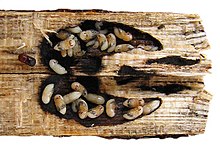Ambrosiella roeperi
Although unnamed Ambrosiella-like fungi had previously been documented from the galleries and mycangia of native X. crassiusculus populations in central Japan,[1] A. roeperi was first described as a novel species of ambrosia fungus by Harrington and McNew in 2014 based on isolations from beetles collected and trapped in the eastern United States, where it is invasive.
All Ambrosiella are ambrosia beetle symbionts and belong to the family Ceratocystidaceae, which, where sexual stages are recognized, produce round, ostiolate (with a pore) fruiting bodies for their ascospores with a fine peridium (outer layer) and aseptate (lacking crosswalls) paraphyses (sterile tissue found among – and arising from the same surface as – spore-bearing cells).
[2] The conidia typically retain at least one adjacent spore-producing cell when broken away from the sporodochia, distinguishing A. roeperi conidiogenous structures from the less swollen, non-detachable conidiophores of A. xylebori; the original species description suggests this feature is meant to allow these units to snap off easily while X. crassiusculus is grazing upon the gallery.
[2] When within the beetle mycangium (a pocket in the insect cuticle for fungal dispersal), A. roeperi can be found as small, several-cell chains with crosswalls; this material is likely derived from chunks of mycelium scraped from the gallery walls and may thus constitute an arthrospore-like structure.
[12] However, no equivalent studies have been performed on A. roeperi specifically, and it is worth noting that the article often cited in support of this conclusion only examined the fungal galleries of one beetle (Xyleborinus saxenii) associated with a different symbiont, Raffaelea sulfurea.
[15] These enzymes are generally needed to help fungi metabolize certain plant chemical defenses, and the loss of these genes may reflect this genus’s association with individuals that are already weakened or dead and thus less likely to be producing effective antifungal metabolites.
[16] According to the current understanding of this symbiosis, when beetles emerge from pupae, their mycangia are inoculated with ambrosial fungi, and special gland cells flanking the mycangium begin to secrete compounds that promote their growth over that of assorted commensals.
[1] It has been suggested that during the height of a beetle attack, the presence of ethanol – produced by stressed trees and sometimes even by the fungus itself – helps to select for the proliferation of A. roeperi over potential competitors such as molds, which are unable to effectively detoxify this compound.
[19] Perhaps in part due to its capacity for extreme polyphagy, this beetle is highly invasive and has spread beyond its native range in southeast Asia to Africa (from tropical regions to the southern tip),[20] Australia and New Zealand,[21] Europe,[22][23] South America,[24] and the United States,[25] taking A. roeperi with it.
As previously mentioned, X. crassiusculus is highly attracted to ethanol produced by stressed trees, in which they can kill twigs, branches, and saplings; this makes them of particular concern in settings such as nurseries and orchards, where the protrusion of noodle-like extrusions of beetle frass can be a diagnostic feature for this and other Xylosandrus.




